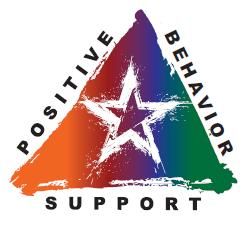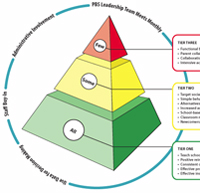
Special Education  Image Credit: resa.net Click to enlarge[/caption]
I had never even heard of PBIS until I got a letter announcing that it was being applied to all students at my son’s elementary school as part of a county-wide initiative. I was skeptical at first. But every single staff member had been trained in it, including the food service and custodial staff. The principal visited every classroom in the building to teach a social skills curriculum based on the school’s motto, “Be Safe, Be Kind, Be Responsible.”
Phase 1:
In the first phase, the principal requested that all staff members keep their eyes open for students who went out of their way to follow the school’s motto. The goal was to get more referrals for positive behavior than incident reports for negative behavior every week. My son got a “green card” when he stopped to help a teacher who had dropped some papers in the hallway.
Phase 2:
In the next phase, every classroom in the school got a numbered pocket chart. Each pocket contained a green card, a yellow card and a red card. Each student was assigned a pocket number, and each student started the day with the green card up front. After three episodes of misbehavior, a student had to change the front card to yellow.
After three more episodes of misbehavior, a student changed the front card to red and had to talk with the principal. But there weren’t many students with red cards. Every teacher followed the guidelines for positive behavior support by teaching expectations, interacting positively and using nonverbal praise as a reinforcer.
At my son’s school, it was important to remind students that they would start the next day with a green card even if they made a mistake on the previous day. No one held grudges. Every week, students with positive behavior referrals entered a schoolwide lottery and proclaimed their own names on the Friday morning announcements.
I never did find out if there was an actual prize for the lottery - the students were just excited about saying their names on the school PA system. Students who maintained green cards every day for a full month were permitted to attend a 20 minute dance party in the gym right after recess. The principal danced with the students at every party. And my son was leading the conga line.
Image Credit: resa.net Click to enlarge[/caption]
I had never even heard of PBIS until I got a letter announcing that it was being applied to all students at my son’s elementary school as part of a county-wide initiative. I was skeptical at first. But every single staff member had been trained in it, including the food service and custodial staff. The principal visited every classroom in the building to teach a social skills curriculum based on the school’s motto, “Be Safe, Be Kind, Be Responsible.”
Phase 1:
In the first phase, the principal requested that all staff members keep their eyes open for students who went out of their way to follow the school’s motto. The goal was to get more referrals for positive behavior than incident reports for negative behavior every week. My son got a “green card” when he stopped to help a teacher who had dropped some papers in the hallway.
Phase 2:
In the next phase, every classroom in the school got a numbered pocket chart. Each pocket contained a green card, a yellow card and a red card. Each student was assigned a pocket number, and each student started the day with the green card up front. After three episodes of misbehavior, a student had to change the front card to yellow.
After three more episodes of misbehavior, a student changed the front card to red and had to talk with the principal. But there weren’t many students with red cards. Every teacher followed the guidelines for positive behavior support by teaching expectations, interacting positively and using nonverbal praise as a reinforcer.
At my son’s school, it was important to remind students that they would start the next day with a green card even if they made a mistake on the previous day. No one held grudges. Every week, students with positive behavior referrals entered a schoolwide lottery and proclaimed their own names on the Friday morning announcements.
I never did find out if there was an actual prize for the lottery - the students were just excited about saying their names on the school PA system. Students who maintained green cards every day for a full month were permitted to attend a 20 minute dance party in the gym right after recess. The principal danced with the students at every party. And my son was leading the conga line.
How To Implement Positive Behavior Support In School
This is part one of a two part series on Positive Behavioral Support (read part one here). Positive behavior support: that phrase got your attention, didn’t it? It sounds like a great idea, but most people don’t actually want to put in the effort for it. Unfortunately, punishment and negative attention – comments such as “Stop it!” and “No!” – seem to come more naturally to most of us. But this idea just won’t go away. So – what is it and why is it here to stay? In part one of this series we discussed the basics of Positive Behavioral Interventions and Supports (PBIS) and how it works. In part two of this series we discuss how PBIS can be implemented in your child's school.Individual support
The great thing about PBIS is that it can be tailored to an individual’s unique needs and written into the IEP so that everyone who works with the individual knows the procedure to follow when dealing with negative behaviors. For example, a student who laughs constantly in class may be consistently told to “switch to the math channel” and acknowledged with a smile every time she completes an assignment or raises her hand to participate in class. For more ingrained behaviors, a behavior plan may be helpful. This is a team approach to target specific behaviors and develop social skills. These students may need an adult mentor and peer-to-peer support in addition to classroom management strategies. The most difficult behaviors require a Functional Behavior Assessment (FBA) to identify behavior patterns. The team may need to train parents in behavior management so that methods are applied consistently at home and at school. Most of these students need intensive academic support and extra structure at home and at school. Additional input from the student’s physician may be requested as well.Schoolwide support
[caption id="attachment_8660" align="alignright" width="200"] Image Credit: resa.net Click to enlarge[/caption]
I had never even heard of PBIS until I got a letter announcing that it was being applied to all students at my son’s elementary school as part of a county-wide initiative. I was skeptical at first. But every single staff member had been trained in it, including the food service and custodial staff. The principal visited every classroom in the building to teach a social skills curriculum based on the school’s motto, “Be Safe, Be Kind, Be Responsible.”
Phase 1:
In the first phase, the principal requested that all staff members keep their eyes open for students who went out of their way to follow the school’s motto. The goal was to get more referrals for positive behavior than incident reports for negative behavior every week. My son got a “green card” when he stopped to help a teacher who had dropped some papers in the hallway.
Phase 2:
In the next phase, every classroom in the school got a numbered pocket chart. Each pocket contained a green card, a yellow card and a red card. Each student was assigned a pocket number, and each student started the day with the green card up front. After three episodes of misbehavior, a student had to change the front card to yellow.
After three more episodes of misbehavior, a student changed the front card to red and had to talk with the principal. But there weren’t many students with red cards. Every teacher followed the guidelines for positive behavior support by teaching expectations, interacting positively and using nonverbal praise as a reinforcer.
At my son’s school, it was important to remind students that they would start the next day with a green card even if they made a mistake on the previous day. No one held grudges. Every week, students with positive behavior referrals entered a schoolwide lottery and proclaimed their own names on the Friday morning announcements.
I never did find out if there was an actual prize for the lottery - the students were just excited about saying their names on the school PA system. Students who maintained green cards every day for a full month were permitted to attend a 20 minute dance party in the gym right after recess. The principal danced with the students at every party. And my son was leading the conga line.
Image Credit: resa.net Click to enlarge[/caption]
I had never even heard of PBIS until I got a letter announcing that it was being applied to all students at my son’s elementary school as part of a county-wide initiative. I was skeptical at first. But every single staff member had been trained in it, including the food service and custodial staff. The principal visited every classroom in the building to teach a social skills curriculum based on the school’s motto, “Be Safe, Be Kind, Be Responsible.”
Phase 1:
In the first phase, the principal requested that all staff members keep their eyes open for students who went out of their way to follow the school’s motto. The goal was to get more referrals for positive behavior than incident reports for negative behavior every week. My son got a “green card” when he stopped to help a teacher who had dropped some papers in the hallway.
Phase 2:
In the next phase, every classroom in the school got a numbered pocket chart. Each pocket contained a green card, a yellow card and a red card. Each student was assigned a pocket number, and each student started the day with the green card up front. After three episodes of misbehavior, a student had to change the front card to yellow.
After three more episodes of misbehavior, a student changed the front card to red and had to talk with the principal. But there weren’t many students with red cards. Every teacher followed the guidelines for positive behavior support by teaching expectations, interacting positively and using nonverbal praise as a reinforcer.
At my son’s school, it was important to remind students that they would start the next day with a green card even if they made a mistake on the previous day. No one held grudges. Every week, students with positive behavior referrals entered a schoolwide lottery and proclaimed their own names on the Friday morning announcements.
I never did find out if there was an actual prize for the lottery - the students were just excited about saying their names on the school PA system. Students who maintained green cards every day for a full month were permitted to attend a 20 minute dance party in the gym right after recess. The principal danced with the students at every party. And my son was leading the conga line.



